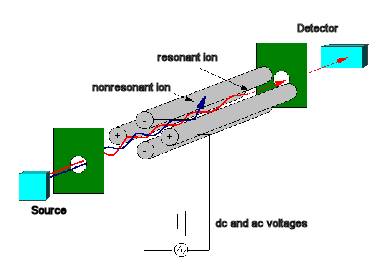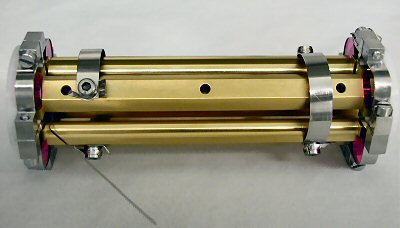


The electron bombardment transfers such a large amount of energy to the molecules that the ions cannot stay together. They fragment – that is, they break apart into smaller pieces. The mass spectrometer “smashes" the atom by overwhelming it with so much energy that it breaks apart. Some fragments created are ions; some fragments are neutral. The neutral fragments will not be filtered by the analyzer and detected, but the ion fragments will.
The ion fragments are guided from the ion source into the quadrupole analyzer using lenses. Lenses are tiny tabs of metal or small, hollow cylinders that have a voltage running through them. By either attracting or repelling the ions, they guide the ions into the quadrupole analyzer.

The quadrupole mass spectrometer used here is made with 4 rods of hyperbolic surfaces. A direct current field is applied to 2 rods and a radio frequency (RF) field is applied to the other 2 rods. These rods generate an electric field through which the ions can move.

The strength and frequency of the RF field determines whether or not an ion of a certain mass passes through the rods (and is counted by the detector) or smashes into a nearby surface. For example, in a 120 volt field at a radio frequency of 2 MHz, only ions of 16 daltons (Da) will navigate through the rods and into the detector. Heavier or lighter ions do not survive the journey to the detector. In this manner, scientists can control the mass of the ions that the detector collects.
Quadrupole image courtesy of SCIMEDIA